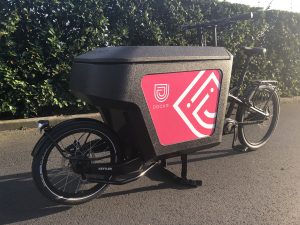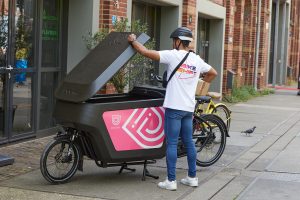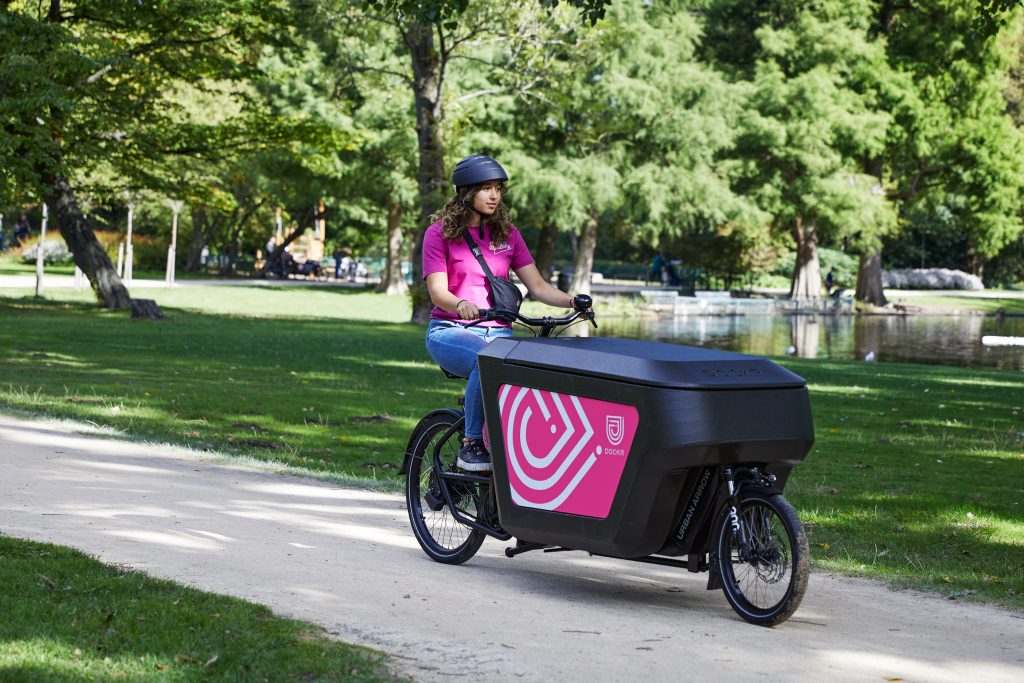Transporting goods with a delivery bike
Just as major retailers like Coolblue and bol.com and couriers like DHL and Post.NL have already discovered, delivery bikes are the answer to overcrowded inner cities.
Where congested inner cities make it almost impossible to drive normally with a delivery vehicle, an electric bike lets you take the cycle path to quickly pass double-parked vans.
Delivery bikes go back a fair few years
The popularity of the delivery bike has – of course – not come out of the blue. And so that you can properly assess the ways you can benefit from a delivery bike, we would like to give you a little background on how the current situation came about.
The 1950s: the cargo bike as a precursor to the delivery van
Delivery bikes are by no means a new development. Around the 1950s, it was really quite normal to make deliveries using a cargo bike. Not with electric drive, of course, but that was all part of the fun!
Late 20th century: vans become more affordable for entrepreneurs
This soon came to an end when cars became more readily available. Vans let you deliver many more orders to people’s homes – and much faster. The cargo bike was consigned to history.
Fast forward to the 21st century: the return of the delivery bike
People are increasingly ordering their things online – and the pandemic expedited this trend even further. Consider this: in 2023, 623 million packages were delivered in the Netherlands, and 92.5% of these were delivered to people’s homes!
Historic inner cities in particular are not built for so much car traffic, and streets have been clogged up for years. You can just see that a fierce problem is going to crop up here.
Package delivery and courier services
As a courier, you have a substantial impact on the quality of life in inner cities. The large number of delivery vans that frequent the roads day in day out to deliver all of those 623 million packages is a thorn in the side of many people.
It also provides a great opportunity for you to showcase yourself as the sustainable alternative. Not only do delivery bikes not emit any CO₂, they also make significantly less noise, which is an impressive USP; and for Fast & Green Delivery Experts it is a key advantage.
Local retailers with own delivery service
How can you, as a local entrepreneur, promise your customers carbon-free delivery to their front doors? More and more consumers are choosing companies that take responsibility. Fornet Textile Care went that step further with a pick-up and delivery service provided using a delivery bike. Can a service be any greener?
Even florists, breweries (Brouwerij Eleven) and coffee experts (Screaming Beans Coffee Roasters) can get noticed when announcing that deliveries are free from emissions thanks to delivery bikes.
Visible marketing is an added bonus. At DOCKR, we can easily apply your branding to your delivery bike, meaning that your bike acts as a poster for your business’s environmentally friendly approach – even when you’re stopped at a delivery address.
Delivery bikes as a solution for congested city centres
Low-traffic city centres are, of course, a great solution for improving the liveability of inner cities in the short term. However, we cannot ignore the fact that there are inevitably many moving parts to consider from a logistics standpoint – precisely because there are so many people living and working there.
Delivery bikes have a key role to play in resolving the imbalance between logistics activities and a liveable environment. Here are some of the possibilities:
Manoeuvrability of delivery bikes in historic inner cities
Delivery bikes are incredibly flexible. You are able to use cycle paths – and bikes (and mopeds) can go both ways down many one-way streets.
You can get around obstacles by briefly taking to the pavement if necessary, and lockable cargo bikes can be easily left on the pavement too. Say goodbye to spending minutes of searching for a parking space and to the inevitable parking tickets.
A transshipment hub on the outskirts
If delivery bikes are to be efficiently integrated into city logistics, then transshipment hubs on the outskirts of inner cities are essential.
This involves (electric) delivery vans first taking the goods to the hubs and bicycle couriers then using their delivery bikes to take care of those last few miles through that congested inner city.
These types of solutions do, however, require a certain volume of packages to make sure that transshipment hubs of this kind can be deployed in a cost-effective way. The relatively low range of electric bikes means that the distance between these hubs and the delivery area they serve should be limited.
If it is planned carefully, this combination of delivery vans for bulk delivery followed by delivery bikes for the last mile would make an excellent solution for city-centre deliveries.
It also reduces CO₂ emissions effectively, and you can make an important contribution towards green, liveable inner cities.
Partnerships with other couriers for national coverage with delivery bikes
In city centres, delivery bikes will beat vans every day of the week – but on main roads they are a bit less practical. That is why courier services in city centres are well served by these bikes; but how can you roll them out on a national scale?
So that it can offer national delivery by bike, Gouda-based Postbedrijf Holland West has partnered with Fietskoerier.nl. They can now offer their customers zero-emission delivery throughout the Netherlands thanks to deliveries made by bike.
A flexible approach thanks to DOCKR’s scalable monthly subscriptions
End of year rush? Black Friday? Cyber Monday? They don’t scare us here at DOCKR. And nor should they scare your bookkeepers. Want to know why?
With DOCKR, you rent by the month. Delivering a bit less one month? Then you can just scale down your fleet. More deliveries coming up during the holiday season? Then you can easily scale up again. This means that you can deploy your fleet as efficiently as possible, and that you don’t have any bikes standing around unused.
The beauty of DOCKR’s subscription model is that our monthly preventative maintenance means we keep downtime to a minimum. Repairs are carried out on your doorstep – and if it takes a little longer than expected, then we will provide a replacement bike for you.
An additional advantage is that you don’t need a driving licence for delivery bikes. Flexibly deploy extra staff for your peak times and you’ll be back on track during the busiest days.
How local and national authorities provide support for using delivery bikes
At DOCKR, we are constantly working on even better ways to support entrepreneurs and a liveable, climate-conscious inner city. Authorities are also aware of the potential of delivery bikes and are developing a range of measures and subsidies for them.
National (and EU) grants
At a national level, the Environmental investment deduction (MIA) and the Arbitrary depreciation of environmental investments (Vamil) schemes are available. With these schemes, the government aims to encourage entrepreneurs to invest in environmentally friendly and innovative assets.
With the MIA, you can deduct up to 45% of your investment costs from the total investment – in addition to your regular investment tax deduction. And with the Vamil you can write off 75% of the investment costs.
This means that your total tax benefit can amount to more than 14% of the investment amount. You can read more about the MIA and Vamil schemes on the MKB Servicedesk website (only available in Dutch).
Provincial and municipal initiatives
30 to 40 municipalities will be expecting to establish zero-emission zones as of 1 January 2025. In doing so, they are keen to support local entrepreneurs so that the zones have the greatest-possible chances of success.
To this end, several municipalities and provinces have launched various initiatives. In some cases, they are choosing to introduce delivery bikes companies in gradual, accessible way, and in other cases they have created subsidies.
Examples include:
- In 2023, as part of a kind of relay race, the Municipality of The Hague gave several companies the opportunity to test the Urban Arrow for a few weeks before passing it on to the next company. Although the trial is now over, you can always try to convince your municipality using this as a case study!
- Rotterdam is also putting a lot of energy into getting entrepreneurs enthusiastic about the shift. They have built a website – Logistics 010 – where they share news, tips, information and case studies. What’s more, they are giving entrepreneurs the opportunity to trial a delivery bike in collaboration with DOCKR. After all, there’s nothing like experiencing it for yourself.
- In Utrecht, the municipality has set up a separate subsidy scheme for entrepreneurs, which is especially for entrepreneurs who are located within the traffic-free zone.
- The Province of Overijssel is not unapologetic either: they are offering a subsidy for up to two cargo bikes. Read more about the initiative here.
So, it is clearly worth checking with your municipality or province to see what options are out there. Some initiatives are more visible than others, and it would be a shame to leave opportunities untested.
Inspired?
Delivery bikes are now an integral part of city life. Want to know how you can give your green mission a boost? Get in touch with one of our experts. We would love to tell you about the possibilities available to you with DOCKR’s delivery bikes.
Delivery bikes can often liberate you from restricted time windows and other limitations when delivering packages. In fact, you won’t even have to find a parking space as you can just leave your bike on the pavement. So, are you curious about the delivery bike’s background, more benefits that delivery bikes bring, and ways in which authorities provide support? Then keep reading!



